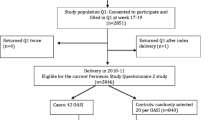Abstract
PURPOSE: The purpose of this study was to determine whether a postpartum bowel-habit questionnaire could reliably identify females who had sustained perineal and anal sphincter trauma after vaginal delivery. METHODS: A prospective cohort design was used to recruit 156 consecutive primigravid females, of whom 134 delivered vaginally without clinical evidence of a third-degree tear. These 134 females completed a specific anal continence questionnaire and underwent anal endosonography before and after delivery to identify those with postpartum deterioration in anal continence and to relate this to sonographic evidence of anoperineal trauma. RESULTS: Anal continence deteriorated in 37 females (27.6 percent) after delivery, 16 of whom (43.2 percent) had sonographic evidence of trauma. There was no postpartum deterioration of continence in the remaining 97 females, 17 (17.5 percent) of whom had sonographic evidence of trauma. Sensitivity, specificity, positive predictive value, and negative predictive value of the questionnaire for sonographic trauma were 48.5, 79.2, 43.2, and 82.5 percent, respectively, with corresponding values of 57.1, 75.8, 21.6, and 93.8 percent for external anal sphincter disruption. CONCLUSION: A bowel-habit questionnaire will detect approximately 60 percent of females who sustain external sphincter tears after vaginal delivery.
Similar content being viewed by others
References
V Donnelly M Fynes D Campbell H Johnson PR O’Connell C O’Herlihy (1998) ArticleTitleObstetric events leading to anal sphincter damage Obstet Gynecol 92 955–961
E Samuelson L Ladfors UB Wennerholm B Gareberg K Nyberg H Hagberg (2000) ArticleTitleAnal sphincter tears Br J Obstet Gynaecol 107 926–931
C MacArthur DE Bick MR Keighley (1997) ArticleTitleFaecal incontinence after childbirth Br J Obstet Gynaecol 104 46–50
S Meyer A Schreyer P De Grandi P Hohlfeld (1998) ArticleTitleThe effects of birth on urinary continence mechanisms and other pelvic floor characteristics Obstet Gynecol 92 613–618
JP Zetterstrom A Lopez B Anzen A Dolk M Norman A Mellgren (1999) ArticleTitleAnal incontinence after vaginal delivery Br J Obstet Gynaecol 106 324–330
A Groutz G Fait JB Lessing et al. (1999) ArticleTitleIncidence and obstetric risk factors of postpartum anal incontinence Scand J Gastroenterol 34 315–318
PJ Law CI Bartram (1989) ArticleTitleAnal endosonography Gastrointest Radiol 14 49–53
AH Sultan MA Kamm CN Hudson CI Bartram (1994) ArticleTitleThird degree obstetric anal sphincter tears BMJ 308 887–891
AH Sultan MA Kamm CN Hudson JM Thomas CI Bartram (1993) ArticleTitleAnal sphincter disruption during vaginal delivery N Engl J Med 329 1905–1911
M Fines V Donnelly M Behan PR O’Connell C O’Herlihy (1999) ArticleTitleEffect of second vaginal delivery on anorectal physiology and faecal continence Lancet 354 983–986
AH Sultan RJ Nicholls MA Kamm CN Hudson J Beynon CI Bartram (1993) ArticleTitleAnal endosonography and correlation with in vitro and in vivo anatomy Br J Surg 80 508–511
AH Sultan MA Kamm IC Talbot RJ Nicholls CI Bartram (1994) ArticleTitleAnal endosonography for identifying external sphincter defects confirmed histologically Br J Surg 81 463–465
JM Jorge SD Wexner (1993) ArticleTitleEtiology and management of fecal incontinence Dis Colon Rectum 36 77–97
A Frudinger CI Bartram S Halligan MA Kamm (1998) ArticleTitleExamination techniques for anal endosonography Abdom Image 23 301–303
AB Williams CI Bartram S Halligan JA Spencer RJ Nicholls WA Kmiot (2001) ArticleTitleAnal sphincter damage after vaginal delivery using three-dimensional endosonography Obstet Gynecol 97 770–775
AH Sultan MA Kamm CN Hudson CI Bartram (1993) ArticleTitleEffect of pregnancy on anal sphincter morphology and function Int J Colorectal Dis 8 206–209
DL Faltin M Boulvain O Irion S Bretones C Stan A Weil (2000) ArticleTitleDiagnosis of anal sphincter tears by postpartum endosonography to predict fecal incontinence Obstet Gynecol 95 643–647
AH Sultan (1997) ArticleTitleAnal incontinence after childbirth Curr Opin Obstet Gynecol 9 320–324
VS Donnelly M Fynes PR O’Connell C O’Herlihy (1997) ArticleTitleThe influence of oestrogen replacement on faecal incontinence in post menopausal women Br J Obstet Gynaecol 104 311–315
A Varma G Gunn SW Lindow GS Duthie (1999) ArticleTitleDo routinely measured delivery variables predict anal sphincter outcome? Dis Colon Rectum 42 1261–1264
DA Drossman Z Li E Andruzzi et al. (1993) ArticleTitleUS householder survey of functional gastrointestinal disorders. Prevalence, sociodemography and health impact Dig Dis Sci 38 1569–1580
KE Hojberg JD Salvig NA Winslow KM Bek S Laurberg NJ Secher (2000) ArticleTitleFlatus and faecal incontinence Br J Obstet Gynaecol 107 1097–1103
AJ Malouf CS Norton AF Engel RJ Nicholls MA Kamm (2000) ArticleTitleLong-term results of overlapping anal-sphincter repair for obstetric trauma Lancet 355 260–265
SL Snooks M Swash SE Mathers MM Henry (1990) ArticleTitleEffect of vaginal delivery on the pelvic floor Br J Surg 77 1358–1360
JW Briel J Stoker E Rociu JS Lameris WC Hop WR Schouten (1999) ArticleTitleExternal anal sphincter atrophy on endoanal magnetic resonance imaging adversely affects continence after sphincteroplasty Br J Surg 86 1322–1327
L Abramowitz I Sobhani R Ganansia et al. (2000) ArticleTitleAre sphincter defects the cause of anal incontinence after vaginal delivery? Results of a prospective study Dis Colon Rectum 43 590–598
Author information
Authors and Affiliations
About this article
Cite this article
Frudinger, A., Halligan, S., Bartram, C.I. et al. Assessment of the Predictive Value of a Bowel Symptom Questionnaire in Identifying Perianal and Anal Sphincter Trauma After Vaginal Delivery. Dis Colon Rectum 46, 742–747 (2003). https://doi.org/10.1007/s10350-004-6651-9
Issue Date:
DOI: https://doi.org/10.1007/s10350-004-6651-9




